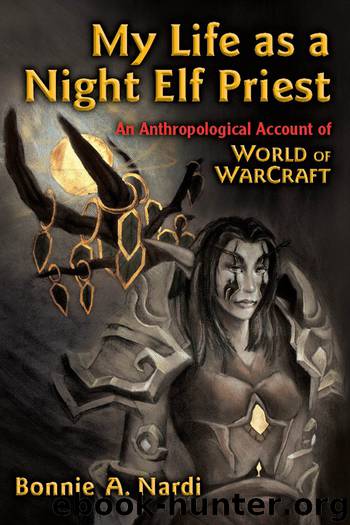My Life as a Night Elf Priest: An Anthropological Account of World of Warcraft by Bonnie A. Nardi

Author:Bonnie A. Nardi
Language: eng
Format: epub
Publisher: The University of Michigan Press
Published: 2018-05-15T00:00:00+00:00
Page 121 →
PART THREE
Cultural Logics of World of Warcraft
Page 122 →
Page 123 →
CHAPTER SIX
Addiction
Having examined theoretical arguments about magic circles, performativity, and so on, this chapter, and the next two, take up broad themes of gaming that are part of academic discourse but also reach into wider arenas of conversation in the mass media and blogs and forums. I begin with the topic of addiction—a perennial favorite of the media and one which seems to crop up often when people ask me about video games.
Many readers will have encountered the notion of video game addiction in newspaper and magazine accounts. Some may know players they believe to be addicted. Players themselves speak of addiction. How exactly should we think about video game addiction? Dewey provides a useful perspective when he discusses the potential for aesthetic activity to become “overwhelming.” I will use this notion, as well as the work of Seay and Kraut (2007) on “problematic use,” to frame my analysis. I extend Seay and Kraut’s work to encompass social aspects of problematic use.
As discussed in chapter 3, Dewey characterized active aesthetic activity as comprised of pleasurable means, successive phases of activity ending in satisfying completion, and collective expression. The final feature Dewey ascribed to aesthetic activity may help us understand why discourse around video gaming includes the term addiction. Dewey argued that aesthetic activity requires balance and proportion— qualities that in some circumstances may readily be lost. The passion that animates aesthetic activity contains within itself a dangerous seed; such passion can transmogrify to an extreme state in which it “overwhelms” us. Dewey (2005) wrote:
There is an element of passion in all aesthetic [activity] . . . [W]hen we are Page 124 →overwhelmed by passion, as in extreme rage, fear, jealousy, the experience is . . . non-aesthetic . . . [T]he material of the experience lacks elements of balance and proportion. For these can be present only when . . . the act is controlled by an exquisite sense of the relations which the act sustains—its fitness to the occasion and the situation. (emphasis added)
Aesthetic activity may become overwhelming in circumstances of particular occasions and relations. The potential for aesthetic activity to devolve into a degenerate form of itself is not an inherent quality of any particular aesthetic activity (such as video gaming) but depends on the specificities of a subject’s situation.
Obviously, millions of people play video games and are not addicted. We must reach beyond the artifact of the game itself as an explanation for why some people play to excess. It is easy to forget this simple logic under the influence of sensationalism in media accounts that deliver dispatches on the shocking nature of video games: this player sat at his computer too long and keeled over, that one dropped out of school because he could not concentrate on his studies, another abandoned friends and family for the game (see Chee and Smith 2005; Golub and Lingley 2008). Rettberg (2008) observed, tongue in cheek:
[T]he popular media
Download
This site does not store any files on its server. We only index and link to content provided by other sites. Please contact the content providers to delete copyright contents if any and email us, we'll remove relevant links or contents immediately.
Cecilia; Or, Memoirs of an Heiress — Volume 1 by Fanny Burney(31322)
Cecilia; Or, Memoirs of an Heiress — Volume 3 by Fanny Burney(30928)
Cecilia; Or, Memoirs of an Heiress — Volume 2 by Fanny Burney(30885)
The Great Music City by Andrea Baker(21195)
We're Going to Need More Wine by Gabrielle Union(18064)
Bombshells: Glamour Girls of a Lifetime by Sullivan Steve(13100)
Pimp by Iceberg Slim(12922)
All the Missing Girls by Megan Miranda(12739)
Fifty Shades Freed by E L James(12443)
Norse Mythology by Gaiman Neil(11873)
Talking to Strangers by Malcolm Gladwell(11861)
Crazy Rich Asians by Kevin Kwan(8340)
Mindhunter: Inside the FBI's Elite Serial Crime Unit by John E. Douglas & Mark Olshaker(7827)
The Lost Art of Listening by Michael P. Nichols(6462)
Enlightenment Now: The Case for Reason, Science, Humanism, and Progress by Steven Pinker(6402)
Bad Blood by John Carreyrou(5761)
The Four Agreements by Don Miguel Ruiz(5502)
Weapons of Math Destruction by Cathy O'Neil(5029)
We Need to Talk by Celeste Headlee(4861)
